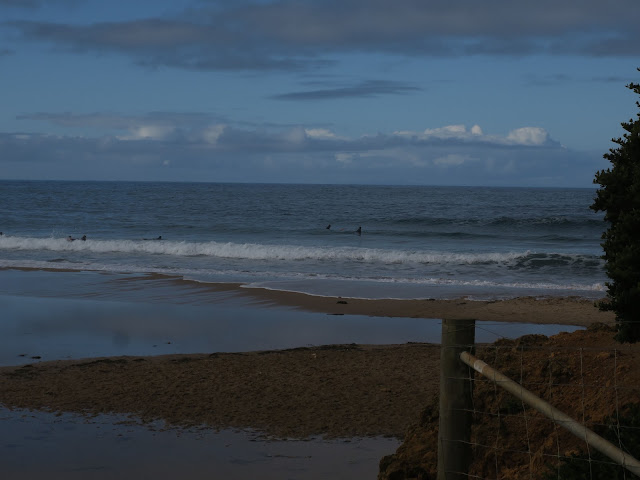On the Victorian 'surfcoast' there are a lot of creative people, which has led our local government to promote an 'arts trail' for the last few years. In the time of physical distancing and our being encouraged to avoid communal gatherings some people have been creative, using strategies that remind me of guerrilla gardeners in suburban settings.
I was delighted to see this 'rainbow' of butterflies that appeared overnight on the fence of the RACV Torquay Resort, which includes the former Torquay Golf Links. I was impressed by the careful graduation of the colour transitions and the variation in the size of the butterflies.
More startling was this ephemeral sand sculpture that appeared on the beach last Tuesday morning. This photo shows about 30 % of its extent. (I had gone down to the beach, knowing that it was low tide, to take a photo for my brother.) The flowing patterns are mostly abstract. However, I noticed that one was in the form of a whale's tail fluke. These patterns are the work of the Sand Whisperers, a local couple whose ephemeral creations are also to be found through the blue link and elsewhere on the internet. Of course these art forms are very appealing to me as a practitioner of ikebana.
This photo from a different angle gives a better sense of the extent of the sculpture.
* * * * *
In the meantime, my students have continued to create ikebana at home and send me their photos.
This ikebana by Marcia was made some weeks ago. She has arranged Dancing Lady orchid and purple Dalia, creating a work of 'Colours in Contrast'.
Eugenia created this simple ikebana responding the the unusual form of her Bizen vase with the twisting line of a succulent.
Ellie created a vertical ikebana two Peonies with three hydrangea leaves in a traditional ikebana vase.
* * * * *
In the garden this week my task was to prune the hydrangeas. They were rather battered by the three 40C+ days we had in January and February.
I took this photo on the 18th January before the first really hot day.
Here is the same plant after pruning. As you can see I have saved one especially tall straight stem as it is particularly thick and it raises the height of the plant above the retaining wall where it sits. The hydrangea leaves had started to colour beautifully and in a different way, as beautiful as the first flowers of six months earlier. Ideal material for ikebana.
This is my single-material ikebana using leaves and stems but no flowers. The line to the left helps emphasise the space in the arrangement and the curving leaves also draw the eye back into the work. What is not apparent is the strong forward movement.
This side view shows that the leaf mass is composed of many stems carefully placed to make the most of the colour of the leaves. Also that the single line in fact projects well forward.
Here is the ikebana in the niche in the living room, where it caught the early morning sunlight. The bowl is by Graeme Wilkie of Qdos Gallery in Lorne.
Greetings from Christopher
14th June 2020.




































